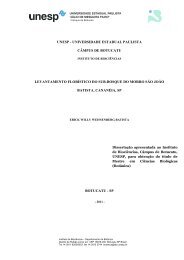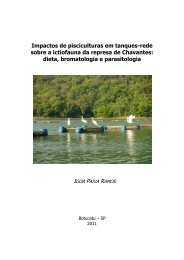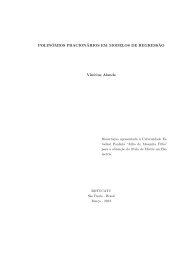Visualizar Tese - Instituto de Biociências - Unesp
Visualizar Tese - Instituto de Biociências - Unesp
Visualizar Tese - Instituto de Biociências - Unesp
Create successful ePaper yourself
Turn your PDF publications into a flip-book with our unique Google optimized e-Paper software.
Andreo Fernando Aguiarexpression patterns in skeletal muscle is still un<strong>de</strong>r discussion. Our data suggest thatother cellular and/or molecular mechanisms (e.g., nervous system, growth factors e/orothers transcription factors) may be involved in MHC isoforms modulation and fibertypestransitions during chronic resistance training. This implies that the increasedmyogenin, MyoD and IGF-I expression may be more associated with control of musclemass than with muscle fiber-type transitions.MRFs. We evaluated two transcription factors important in myogenic processes(myogenin and MyoD) and found that RT during 8 and 12 weeks induced a markedincrease in myogenin (T8: 44.8% and T12: 37,7%) and MyoD (T8: 22,9% and T12:22,3%) mRNA expression (Fig. 9B and C) This increase is not surprising consi<strong>de</strong>ringprevious human (47, 8) and animal (45) studies that examined the acute myogenicresponse to resistance exercise; these studies show an increase in myogenin and MyoDmRNA expression after a single bout of RT, suggesting that these MRFs may beinvolved in initial hypertrophic response to RT. However, most of these studiesexamined the molecular responses on a scale of hours, to establish a time course for theactivation of myogenic mechanisms. Thus, it is still unclear if response of MRFs occursduring the adaptation to long-term RT.The important novel observation of our study was that both myogenin andMyoD mRNA expression were upregulated during 8 and 12 weeks of RT; this increasewas accompanied by an increase in muscle fibers CSA (Fig. 6E) The increase inmyogenin and MyoD mRNA expression is consistent with the important role of MRFsin hypertrophy mediated by activation of satellite cells (SC) (13). Several studies haveshown that muscle injury induces satellite cell activation and MRFs expression (33, 38).The MRFs regulates the expression of muscle-specific genes and are involved inproliferation (MyoD, myf-5) and differentiation (myogenin, myf-6) of SCs in responseto load-induced activation (9, 22). It has been <strong>de</strong>monstrated that myogenin and MyoDexpression is essential for successful skeletal muscle hypertrophy (28, 37). Consi<strong>de</strong>ringthat proliferation, differentiation, and fusion of CS to preexisting fibers are necessary ifthe hypertrophy response is to continue during longer periods of mechanical overload(37, 48), it seems reasonable to assume that myogenin and MyoD are involved inregulating long-term muscle hypertrophy.IGF-I. In addition to important role of MRFs in load-induced hypertrophy, theIGF-I has been indicated as a potential mediator of hypertrophy in response to loadinducedmuscle injury. Previous study report an increase in muscle IGF-I expression in64
















